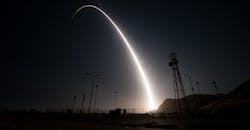The Air Force Life Cycle Management Center (AFLCMC-Hanscom) has selected Boecore to provide maintenance and sustainment capabilities for the Shared Early Warning System (SEWS) as part of a $93 million small-business contract. Headquartered in Colorado Springs, Co., Boecore specializes in maintaining defense electronic systems, including missile defense and cyber security systems.
The SEWS system provides uninterrupted reporting on potential adversarial ballistic missile launches, providing information to U.S. allies with a bilateral agreement in place regarding defense. SEWS serves nine partner nations, providing early warning of possible strikes so that countermeasures can be prepared. “A missile launch starts a timer,” noted SEWS Program Manager Captain Frank Schiavone “We’re working hard to provide the combatant commands and partner nations with as many extra seconds as possible so they can begin countermeasures, warn their populations, and protect themselves.”
“We have a network of sensors and clients dedicated to several unified combatant commands and nine foreign partner nations, so the back-end servers and communications devices require flexible technical capabilities,” added Colonel Todd Wiest, senior materiel leader for the Strategic Warning and Surveillance Systems Div. “Small businesses are very agile and flexible.”
The SEWS system is managed by a team of 67 airmen, government civilians, and contractors. The system works with a constellation of heat-detecting U.S. satellites to gather intelligence on ballistic missile activity. In addition, each partner nation has multiple constantly monitored SEWS sites for sharing of intelligence. This latest contract brings the agility and expertise into the mix to maintain the performance of the computers and communications systems that are part of the SEWS system.
“Improvements on the new contract will focus on the ability to receive new message formats and an extensive system architecture upgrade project to modernize the system,” Schiavone said. “The Combatant Commands and SEWS partners are relying on these future advancements to overcome the mounting threats around the world.”
About the Author
Jack Browne
Technical Contributor
Jack Browne, Technical Contributor, has worked in technical publishing for over 30 years. He managed the content and production of three technical journals while at the American Institute of Physics, including Medical Physics and the Journal of Vacuum Science & Technology. He has been a Publisher and Editor for Penton Media, started the firm’s Wireless Symposium & Exhibition trade show in 1993, and currently serves as Technical Contributor for that company's Microwaves & RF magazine. Browne, who holds a BS in Mathematics from City College of New York and BA degrees in English and Philosophy from Fordham University, is a member of the IEEE.

